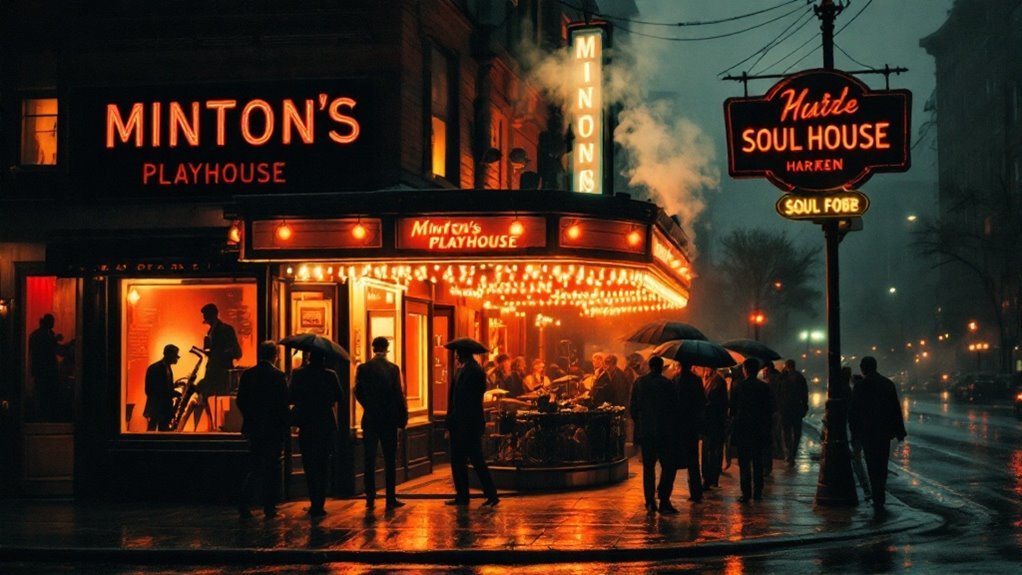Harlem offers a rich tapestry of African-American culture through its historic jazz clubs, soul food restaurants, and architectural landmarks. Venues like Bill’s Place and Minton’s Playhouse preserve the neighborhood’s musical legacy. Iconic eateries Sylvia’s and Amy Ruth’s serve authentic soul food classics. The Apollo Theater, Abyssinian Baptist Church, and Schomburg Center stand as pillars of cultural heritage. This cultural hub holds countless stories within its storied streets and institutions.
Key Takeaways
- Bill’s Place and Minton’s Playhouse offer authentic jazz experiences, preserving Harlem’s musical legacy through live performances.
- Sylvia’s Restaurant and Amy Ruth’s serve iconic soul food dishes that represent Harlem’s rich culinary traditions.
- The Apollo Theater combines historical significance with contemporary relevance through its famous Amateur Night showcases.
- The Schomburg Center and Studio Museum preserve African-American cultural heritage through literature, art, and historical artifacts.
- Historic brownstones and architectural landmarks like Hamilton Grange reflect Harlem’s evolution and cultural significance.
Must-Visit Jazz Venues: Where Music History Lives On
When it comes to experiencing authentic jazz in New York City, Harlem’s historic venues remain unrivaled.
The legendary Bill’s Place occupies the same brownstone speakeasy where Billie Holiday first performed, offering intimate Friday night jazz sessions in a prohibition-era setting.
Step back in time at Bill’s Place, where Billie Holiday’s voice once filled this historic Harlem speakeasy during intimate jazz performances.
At Minton’s Playhouse, where bebop was born, visitors can witness contemporary artists perform on the same stage where giants like Thelonious Monk and Dizzy Gillespie once played.
The Apollo Theater continues its tradition of showcasing emerging talent through Amateur Night, while preserving its status as a jazz landmark.
For a more casual experience, Paris Blues, operating since 1969, provides nightly live jazz with no cover charge.
The Shrine, a modern addition to the scene, combines classic jazz with Afro-beat and Latin rhythms in a vibrant atmosphere.
Experience Authentic Harlem: Historic Sites & Legendary Restaurants
Beyond its musical heritage, Harlem’s soul lies in its historic landmarks and culinary institutions that have shaped African-American culture for generations.
The Apollo Theater stands as a monument to artistic excellence, while the Abyssinian Baptist Church represents spiritual resilience. The Schomburg Center preserves vital African-American literature and artifacts.
Culinary landmarks include Sylvia’s Restaurant, serving soul food classics since 1962, and Amy Ruth’s, famous for its chicken and waffles.
The iconic Lenox Lounge building, though no longer operational, remains an architectural gem of Art Deco design.
The Studio Museum showcases African-American fine arts, while the Hamilton Grange National Memorial offers insight into founding father Alexander Hamilton’s Harlem home.
These enduring institutions continue to draw visitors seeking authentic cultural experiences in this historic neighborhood.
FAQ
What Is the Best Time of Year to Experience Harlem’s Street Festivals?
The best time to experience Harlem’s street festivals is during the summer months, particularly from June through September.
Major events like the Harlem Week Festival in July and August draw thousands of visitors with live music, food vendors, and cultural performances.
The warm weather creates an ideal atmosphere for outdoor celebrations, while festivals like the Dance Africa Street Bazaar showcase local artisans and performers.
Are There Guided Walking Tours Available Specifically for Harlem’s Art Galleries?
With over 40 art galleries concentrated in Harlem’s vibrant arts district, several tour operators offer specialized gallery walks.
ArtCrawl Harlem provides weekly guided tours exploring contemporary and historical African-American art spaces.
Harlem One Stop and Welcome to Harlem both conduct regular gallery circuits, while the Studio Museum offers docent-led tours highlighting emerging artists.
Most tours run Thursday through Sunday and require advance reservations.
Which Subway Lines Provide the Safest Late-Night Access to Harlem?
The A, B, C, and D lines running along Central Park North/125th Street station provide reliable 24-hour service to Harlem. These express trains are well-lit and frequently patrolled.
The 2 and 3 lines along Lenox Avenue/125th Street are also dependable options.
For added security, riders should wait in designated waiting areas near station booths and use well-populated subway cars near the conductor’s position.
Where Can Visitors Find Authentic Gospel Performances in Harlem Churches?
While some visitors worry about intruding on religious services, many Harlem churches welcome respectful tourists.
The Abyssinian Baptist Church on West 138th Street offers renowned Sunday gospel services, though arriving early is essential.
Mount Moriah Baptist Church and Mother AME Zion Church also feature powerful gospel choirs.
First Corinthian Baptist Church provides a more intimate experience, but visitors should dress modestly and follow church protocols.
What Are the Typical Cover Charges for Harlem’s Jazz Clubs?
Cover charges at Harlem’s jazz clubs typically range from $15 to $35 per person, varying by venue and performer.
Iconic establishments like Bill’s Place and Minton’s Playhouse usually charge around $20-25, while larger venues such as the Cotton Club may command higher fees of $30-35.
Many clubs also require a minimum food or drink purchase in addition to the cover charge, generally between $15-20 per person.






